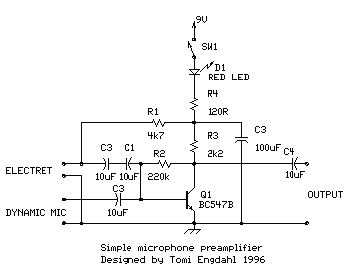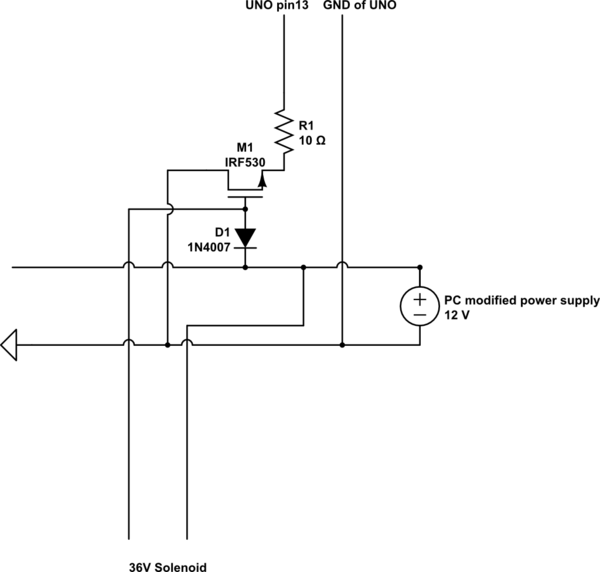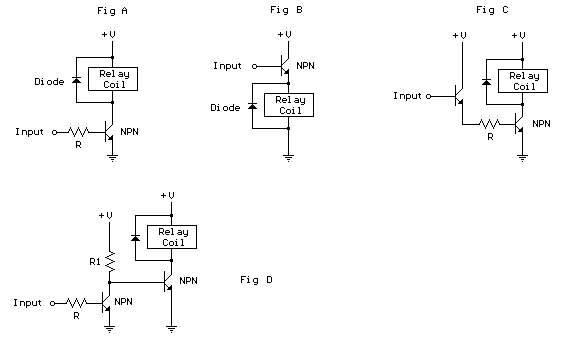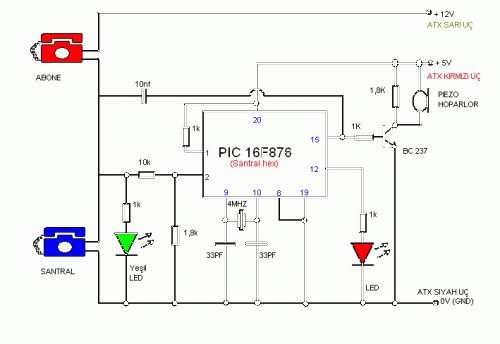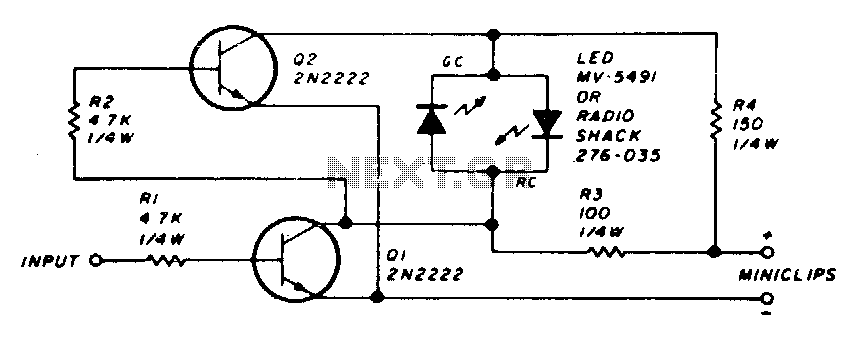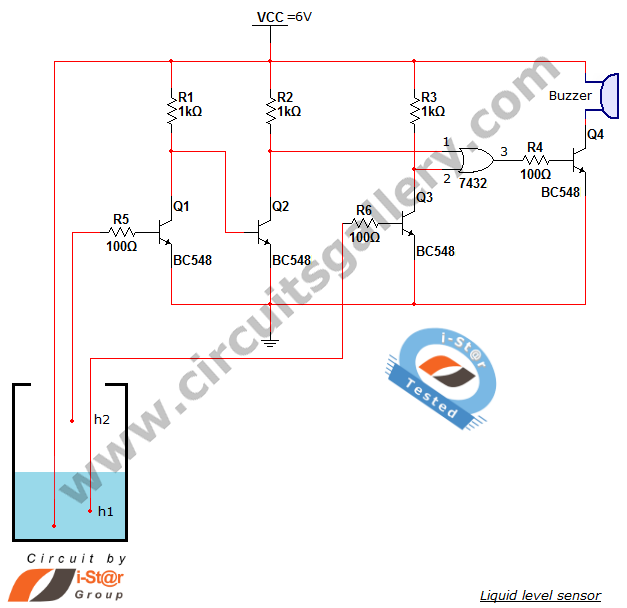
Logic Probe Project
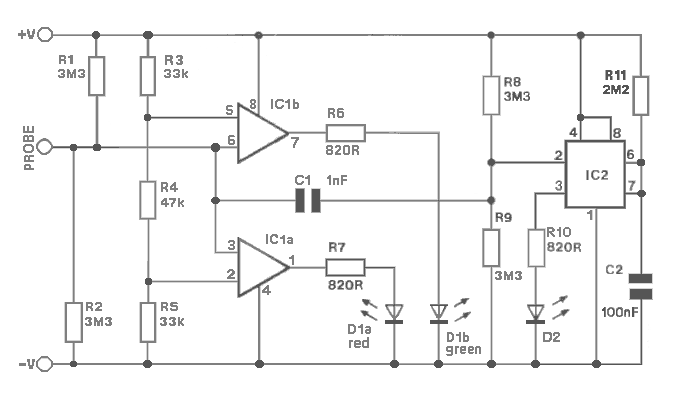
CMOS logic integrated circuits are highly versatile devices commonly utilized in modern electronic circuits. Testing these circuits with a standard multi-meter can be challenging due to the involvement of both static and pulsing voltages. A voltage reading of half the supply potential may indicate a fault or could result from a high-frequency square wave signal, which averages to half the supply voltage without any fault in the circuit. An oscilloscope is the ideal tool for testing such equipment; however, when it is not available, a logic probe serves as an excellent alternative. This simple logic probe is designed for use with CMOS logic circuits, powered by the circuit under investigation, with a current consumption of approximately 0 to 20 mA, depending on the supply voltage and the logic state indicated by the probe. The logic state detected by the unit is represented by a two-LED display: one multicolor LED and one ordinary green LED. The display response to various input signal conditions is as follows: when the input is pulsing rapidly, the multicolor LED may show red or green instead of yellow, indicating that the mark-space ratio of the input signal is not one-to-one. The LED will be red if the input is high for most of the time and green if it is predominantly low. For slowly pulsing inputs, unless the pulses are extremely brief, the LED will alternate between red and green in sync with the input signal. Separate stages drive the two indicator LEDs, utilizing a dual operational amplifier for the multicolor LED and a 555 monostable for the green LED. The circuit diagram of the CMOS Logic Probe illustrates that both sections of the operational amplifier are configured as voltage comparators. Each comparator has one input connected to a reference voltage while the other is connected to the probe input. The probe indicates a high input state if the input voltage exceeds approximately 70% of the supply voltage and a low state if it is below about 30% of the supply potential. Resistors R3 to R5 form a potential divider providing reference voltages of approximately 30% and 70% of the supply voltage. When the input is low, the non-inverting input of the first comparator is at a higher potential than the inverting input, resulting in a high output that activates the multicolor LED. Conversely, the second comparator's output goes low, turning off the green LED, thus indicating a green state. When the input is high, the first comparator's inverting input exceeds the non-inverting input, causing its output to drop low and deactivate the multicolor LED, while the second comparator's output goes high, activating the green LED for a red indication. If the input voltage is between the two logic states, both comparators output high, causing the multicolor and green sections of the LED to illuminate, producing a yellow display. Resistors R1 and R2 bias the input between the two logic levels, indicating a fault condition (yellow state) if the input is connected to an open circuit. This configuration does not allow differentiation between a static voltage near the threshold and a high-frequency pulse signal, as both conditions can activate both sections of the LED, resulting in a yellow display due to rapid switching. To address this, the input signal is applied to the trigger input of a 555 monostable. Resistors R8 and R9 typically hold the input of the 555 timer above the trigger threshold; however, a pulsing input signal couples through capacitor C1, activating the timer on negative transitions. The green LED indicator illuminates for approximately 0.25 seconds each time the timer is triggered, and with a high-frequency input, the circuit retriggers almost immediately after each output pulse, causing the LED to appear continuously lit. Capacitor C1 blocks steady-state inputs from triggering the timer, allowing for a brief flash from the green LED only when the input transitions to a new logic state.
Resistor specifications include R1, R2, R8, and R9 at 3.3 MΩ (orange, orange, green), R3 and R5 at 33 kΩ (orange, orange, orange), R4 at 47 kΩ (yellow, violet, orange), R6, R7, and R10 at 820 Ω (gray, red, brown), and R11 at 2.2 MΩ (red, red, green). Capacitor C1 is 1 nF (103Z) ceramic, while C2 is a 100 nF poly film (DT98G). The semiconductors include IC1 (CA3240E, recommended replacement: LM393N voltage comparator) and IC2 (555 timer, recommended replacement: NE555N). The logic probe utilizes a common cathode two-color LED and features a rectangular shape for the green LED. Miscellaneous components include wire links (LK1-7) and gold crocodile clips (CN1 for red and CN2 for black). The probe tip can be constructed from a long M3 bolt, and the assembly is housed in a compact case, facilitating handheld operation. The circuit connections are made easy with approximately half-meter-long supply leads terminated in color-coded crocodile clips for clear identification. The Veroboard layout for the CMOS Logic Probe is designed for a board with 12 copper strips and 26 holes, ensuring straightforward construction while adhering to proper handling precautions for the MOS device used in the circuit.CMOS logic integrated circuits are extremely versatile devices which are used a great deal in modern electronic circuits. Like any logic circuits, those which employ CMOS devices can be difficult to test using an ordinary multi-meter as both static and pulsing voltages are involved.
A voltage reading of half the supply potential could be a static voltage and indicative of a fault, or it could be produced by a high frequency squarewave signal giving an average voltage of half the supply voltage with no fault present in this part of the circuit. Ideally an oscilloscope should be used for testing this type of equipment, but where this is not possible for some reason a logic probe makes an excellent alternative.
This simple logic probe is intended for use with CMOS logic circuits, is powered from the circuit under investigation, and has a current consumption of only around 0 to 20mA (depending on the supply voltage and logic state indicated by the probe). The logic state detected by the unit is indicated by a two-LED display: one of the display LEDs IS a multicolour type and the other is an ordinary green type.
The following table shows the display obtained from various input signal conditions. When the input is pulsing at high speed it is possible that D1 will be red or green instead of yellow, and this simply indicates that the mark-space-ratio of the input signal is far from being one-to-one. D1 will be red if the input is high for the majority of the time, or green if it is predominantly low.
If the input is pulsing slowly, unless the pulses are extremely brief, D1 will be seen to switch from red to green and so on in sympathy with the input signal. Separate stages are used to drive the two indicator LEDs, a dual operational amplifier being used to drive D1 and a 555 monostable driving D2.
Figure 1 shows the circuit diagram of the CMOS Logic Probe. Both sections of IC1 are used as voltage comparators rather than operational amplifiers, and these each have one input connected to a reference voltage, and the other taken to the input of the probe. The unit must indicate a high input state if the input voltage is more than about 70% of the supply voltage, and allow input state if the input is at less than about 30% of the supply potential.
R3 to R5 form a potential divider which gives reference voltages of approximately 30% and 70% of the supply voltage. If the input is low, IC1a`s non-inverting input will be at a higher potential than the inverting input so that the output goes high and switches on D1b.
IC1b has the opposite input states so that its output goes low and D1a is switched off. This gives a green indication from D1. With the input in the high state IC1a`s inverting input is taken to a higher voltage than the non-inverting input, causing the output to go low and switch off D1b. IC1b`s non-inverting input will now be at a higher voltage than the inverting input, causing IC1b`s output to go high and switch on D1a so that a red indication is obtained from D1.
If the input is between the two logic states the outputs of the two comparators will both assume the high state so that the red and green sections of D1 switch on to produce a yellow display. R1 and R2 bias the input between the two logic levels so that the unit will indicate a fault condition (with D1 in the yellow state) if the input is taken to an open circuit test point.
This section of the circuit does not enable the user to differentiate between a static level between the two logic states and a high frequency pulse signal, since the latter will cause both sections of D1 to switch on in turn and give the impression of a yellow display due to the switching action being too fast to be seen. This is overcome by applying the input signal to the trigger input of a 555 monostable. Normally R8 and R9 hold the input of IC2 above the trigger threshold, but if there IS a pulsing input signal it will be coupled to the input of IC2 by C1 and on negative transistions IC2 will be activated.
LED indicator D2 is then switched on for about 0. 25 seconds each time IC2 is triggered, but with a high frequency input signal the circuit will be retriggered almost as soon as each output pulse ceases, and D2 will appear to light continuously. C1 blocks steady state inputs so that IC2 is not triggered, except possibly for a single triggering when the input is taken to a new logic state, with a consequent brief flash from D2.
Resistors - ALL Min Res R1, 2, 8, 9 3M3 (Orange Orange Green) 4 off (M3M3) - 13p R3, 5 33k (Orange Orange Orange) 2 off (M33K) - 9p R4 47k (Yellow Violet Orange) (M47K) - 9p R6, 7, 10 820W (Grey Red Brown) 3 off (M820R) - 9p R11 2M2 (Red Red Green) (M2M2) - 13p Colour Code Convertor PC Windows Programme. Very good and easy to us. I recommend it! Capacitors C1 1 nF (103Z) Ceramic 1 (Discontinued) All ceramics are measured in pico farads. So 104 = 10, 000 pico farads = 10 nano farads. See Engineering Notations for description of measurements. C2 100n Poly Film (DT98G) - 10p Semiconductors IC1 CA3240E - Use LM393N Voltage Comparator (Discontinued) - Was £1.
38 IC2 555 Timer - NE555N - replacement for ICM7555 (GH66W) - 37p D1 Common cathode 2 colour LED (Discontinued) D2 [Rectangular] Shape LED R1 Green (YY46A) - 16p Miscellaneous LK1-7 Wire links between circuit tracks. CN1 Gold Croc Clip Red (FS53J) - 52p CN2 Gold Croc Clip Black (FS55K) - 52p One Meter of 2-way Cable for power lead.
Logic Probe Tip - Long M3 bolt Small moulded black plastic case (FT31) - 99p 124mm long by 33mm wide by 30mm deep Vero-board, 81 x 14 holes - Stripboard (FL17T) - £4. 99 All components available from Maplin Electronics on-line (through the Post or from there 40 UK Shops).
The Logic Probe project was published in the Maplin Magazine. Maplin Electronics - postal retailer with shops of 12, 000 quality Electronic Components and Items, large stock, own catalogue. P&P £2. 50, free over £35 incl. VAT. The Veroboard layout for the CMOS Logic Probe is shown In Figure 2 and this is based on a board having 12 copper strips by 26 holes.
Construction of the board is quite straightforward apart from the fact that IC1 is a MOS device, and the normal MOS handling precautions must be taken with this device. IC2 is a CMOS device but due to its internal protection circuitry it does not require any handling precautions.
In use the unit will probably be most convenient if it is fitted in a small case that can be comfortably hand-held. Thee probe tip, which can simply consist of a long M3 bolt, is fitted at the front end of the case and the two display LEDs are mounted off-board at the rear end of the case.
The case is drilled to take the two supply leads, and these are about half a metre long and terminated in crocodile clips to permit easy connection to the circuit under test. The crocodile clips are different colours (red for the positive lead and black for the negative one) so that the two leads are easily identified.
🔗 External reference
Resistor specifications include R1, R2, R8, and R9 at 3.3 MΩ (orange, orange, green), R3 and R5 at 33 kΩ (orange, orange, orange), R4 at 47 kΩ (yellow, violet, orange), R6, R7, and R10 at 820 Ω (gray, red, brown), and R11 at 2.2 MΩ (red, red, green). Capacitor C1 is 1 nF (103Z) ceramic, while C2 is a 100 nF poly film (DT98G). The semiconductors include IC1 (CA3240E, recommended replacement: LM393N voltage comparator) and IC2 (555 timer, recommended replacement: NE555N). The logic probe utilizes a common cathode two-color LED and features a rectangular shape for the green LED. Miscellaneous components include wire links (LK1-7) and gold crocodile clips (CN1 for red and CN2 for black). The probe tip can be constructed from a long M3 bolt, and the assembly is housed in a compact case, facilitating handheld operation. The circuit connections are made easy with approximately half-meter-long supply leads terminated in color-coded crocodile clips for clear identification. The Veroboard layout for the CMOS Logic Probe is designed for a board with 12 copper strips and 26 holes, ensuring straightforward construction while adhering to proper handling precautions for the MOS device used in the circuit.CMOS logic integrated circuits are extremely versatile devices which are used a great deal in modern electronic circuits. Like any logic circuits, those which employ CMOS devices can be difficult to test using an ordinary multi-meter as both static and pulsing voltages are involved.
A voltage reading of half the supply potential could be a static voltage and indicative of a fault, or it could be produced by a high frequency squarewave signal giving an average voltage of half the supply voltage with no fault present in this part of the circuit. Ideally an oscilloscope should be used for testing this type of equipment, but where this is not possible for some reason a logic probe makes an excellent alternative.
This simple logic probe is intended for use with CMOS logic circuits, is powered from the circuit under investigation, and has a current consumption of only around 0 to 20mA (depending on the supply voltage and logic state indicated by the probe). The logic state detected by the unit is indicated by a two-LED display: one of the display LEDs IS a multicolour type and the other is an ordinary green type.
The following table shows the display obtained from various input signal conditions. When the input is pulsing at high speed it is possible that D1 will be red or green instead of yellow, and this simply indicates that the mark-space-ratio of the input signal is far from being one-to-one. D1 will be red if the input is high for the majority of the time, or green if it is predominantly low.
If the input is pulsing slowly, unless the pulses are extremely brief, D1 will be seen to switch from red to green and so on in sympathy with the input signal. Separate stages are used to drive the two indicator LEDs, a dual operational amplifier being used to drive D1 and a 555 monostable driving D2.
Figure 1 shows the circuit diagram of the CMOS Logic Probe. Both sections of IC1 are used as voltage comparators rather than operational amplifiers, and these each have one input connected to a reference voltage, and the other taken to the input of the probe. The unit must indicate a high input state if the input voltage is more than about 70% of the supply voltage, and allow input state if the input is at less than about 30% of the supply potential.
R3 to R5 form a potential divider which gives reference voltages of approximately 30% and 70% of the supply voltage. If the input is low, IC1a`s non-inverting input will be at a higher potential than the inverting input so that the output goes high and switches on D1b.
IC1b has the opposite input states so that its output goes low and D1a is switched off. This gives a green indication from D1. With the input in the high state IC1a`s inverting input is taken to a higher voltage than the non-inverting input, causing the output to go low and switch off D1b. IC1b`s non-inverting input will now be at a higher voltage than the inverting input, causing IC1b`s output to go high and switch on D1a so that a red indication is obtained from D1.
If the input is between the two logic states the outputs of the two comparators will both assume the high state so that the red and green sections of D1 switch on to produce a yellow display. R1 and R2 bias the input between the two logic levels so that the unit will indicate a fault condition (with D1 in the yellow state) if the input is taken to an open circuit test point.
This section of the circuit does not enable the user to differentiate between a static level between the two logic states and a high frequency pulse signal, since the latter will cause both sections of D1 to switch on in turn and give the impression of a yellow display due to the switching action being too fast to be seen. This is overcome by applying the input signal to the trigger input of a 555 monostable. Normally R8 and R9 hold the input of IC2 above the trigger threshold, but if there IS a pulsing input signal it will be coupled to the input of IC2 by C1 and on negative transistions IC2 will be activated.
LED indicator D2 is then switched on for about 0. 25 seconds each time IC2 is triggered, but with a high frequency input signal the circuit will be retriggered almost as soon as each output pulse ceases, and D2 will appear to light continuously. C1 blocks steady state inputs so that IC2 is not triggered, except possibly for a single triggering when the input is taken to a new logic state, with a consequent brief flash from D2.
Resistors - ALL Min Res R1, 2, 8, 9 3M3 (Orange Orange Green) 4 off (M3M3) - 13p R3, 5 33k (Orange Orange Orange) 2 off (M33K) - 9p R4 47k (Yellow Violet Orange) (M47K) - 9p R6, 7, 10 820W (Grey Red Brown) 3 off (M820R) - 9p R11 2M2 (Red Red Green) (M2M2) - 13p Colour Code Convertor PC Windows Programme. Very good and easy to us. I recommend it! Capacitors C1 1 nF (103Z) Ceramic 1 (Discontinued) All ceramics are measured in pico farads. So 104 = 10, 000 pico farads = 10 nano farads. See Engineering Notations for description of measurements. C2 100n Poly Film (DT98G) - 10p Semiconductors IC1 CA3240E - Use LM393N Voltage Comparator (Discontinued) - Was £1.
38 IC2 555 Timer - NE555N - replacement for ICM7555 (GH66W) - 37p D1 Common cathode 2 colour LED (Discontinued) D2 [Rectangular] Shape LED R1 Green (YY46A) - 16p Miscellaneous LK1-7 Wire links between circuit tracks. CN1 Gold Croc Clip Red (FS53J) - 52p CN2 Gold Croc Clip Black (FS55K) - 52p One Meter of 2-way Cable for power lead.
Logic Probe Tip - Long M3 bolt Small moulded black plastic case (FT31) - 99p 124mm long by 33mm wide by 30mm deep Vero-board, 81 x 14 holes - Stripboard (FL17T) - £4. 99 All components available from Maplin Electronics on-line (through the Post or from there 40 UK Shops).
The Logic Probe project was published in the Maplin Magazine. Maplin Electronics - postal retailer with shops of 12, 000 quality Electronic Components and Items, large stock, own catalogue. P&P £2. 50, free over £35 incl. VAT. The Veroboard layout for the CMOS Logic Probe is shown In Figure 2 and this is based on a board having 12 copper strips by 26 holes.
Construction of the board is quite straightforward apart from the fact that IC1 is a MOS device, and the normal MOS handling precautions must be taken with this device. IC2 is a CMOS device but due to its internal protection circuitry it does not require any handling precautions.
In use the unit will probably be most convenient if it is fitted in a small case that can be comfortably hand-held. Thee probe tip, which can simply consist of a long M3 bolt, is fitted at the front end of the case and the two display LEDs are mounted off-board at the rear end of the case.
The case is drilled to take the two supply leads, and these are about half a metre long and terminated in crocodile clips to permit easy connection to the circuit under test. The crocodile clips are different colours (red for the positive lead and black for the negative one) so that the two leads are easily identified.
🔗 External reference
